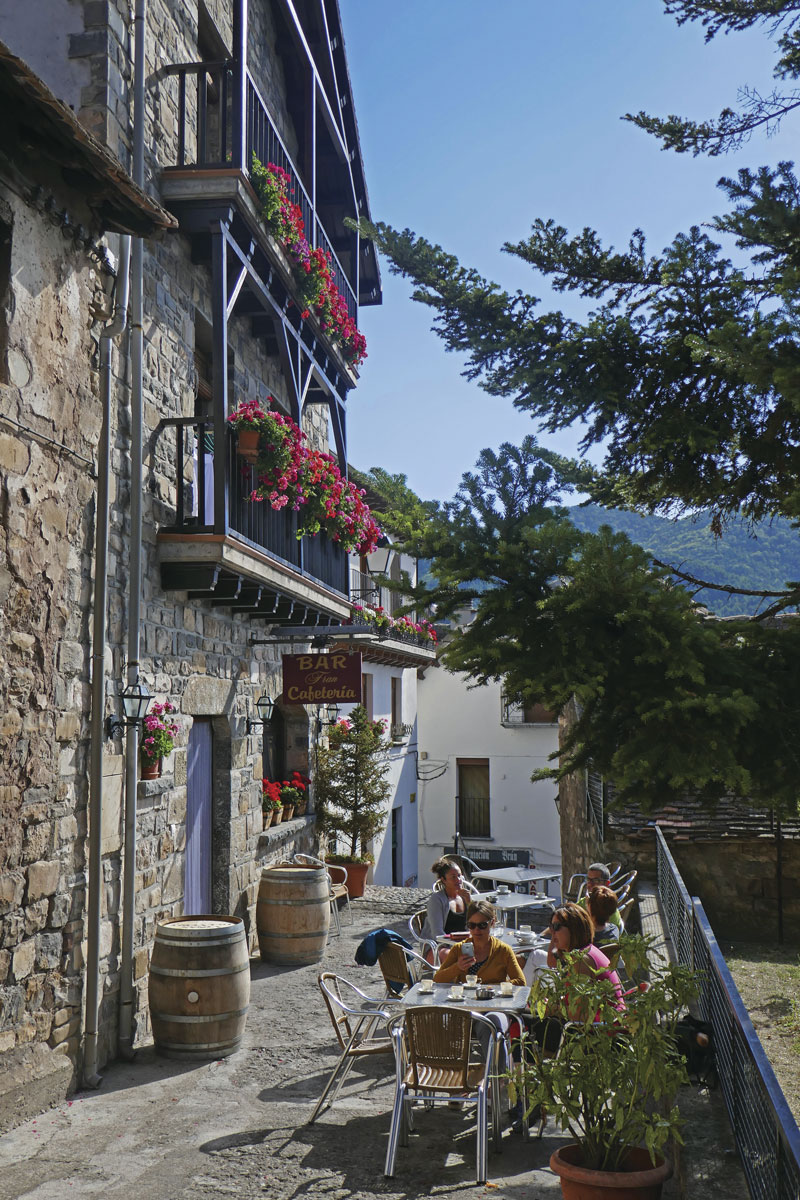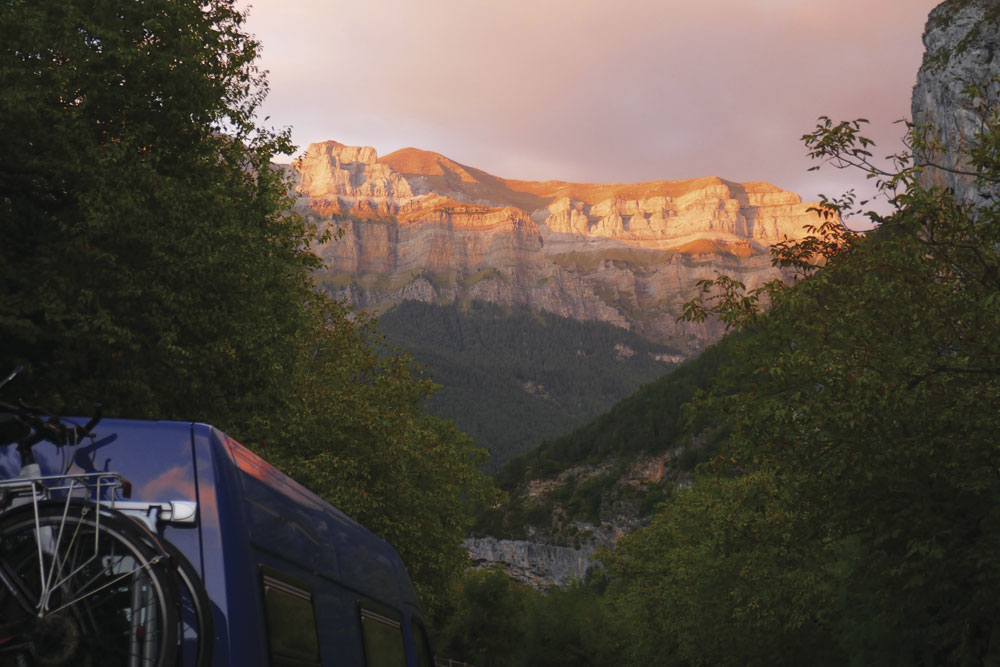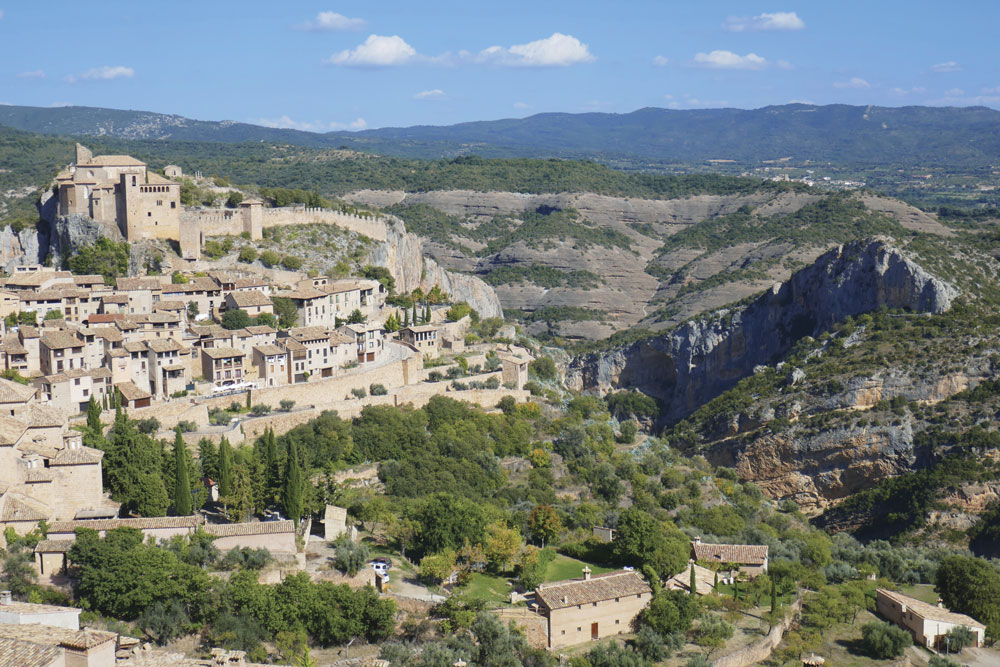Motorhome travel: The stunning Spanish Pyrenees
See also: Campervan: Travel and Destination Guide
Words and photos: Carol Kubicki
Do stunning mountains, pretty villages, rugged canyons with rivers of clear blue water, skies full of stars and sunny café terraces inspire your holiday planning?
If so, then you will love the Spanish Pyrenees, the sunny side of the mountains between France and Spain, as much as I do. Drive off the ferry in Bilbao and you can soon be in the landlocked hilly region of Aragón and hiking among these spectacular mountains.
Sensational Spain
We weren’t rushing so a short diversion to the Sierra de Urbasa near Pamplona gave us a chance to warm up our walking legs before the Pyrenean Peaks. The road snakes up the hillside to a short tunnel that cuts through the escarpment, emerging onto a plateau at Puerto de Lizarraga where there is a large car park. Under a blue sky we were soon striding out along the dazzlingly white track to Ermita (hermitage) de San Adrián. A shepherd herded his flock over a limestone ridge and griffon vultures and kites circled above.
Bypassing Pamplona the next day the mountains soon came into sight. We reached the Embalse (reservoir) de Yesa and Aragón and pulled in to stretch our legs for the short ascent up to the tumbledown village of Escó. In such an evocative spot among the derelict houses, Anthony began whistling tunes from spaghetti westerns – it was eerie! There were no signs of life but reports suggest that one or two houses here are still occupied. I wandered wistfully, spotting ghosts of previous residents among the ruins. Balconies that were once bright with geraniums and draped with washing now hung empty and the village elders no longer sat in the shady side of the street.
Exploring Hecho's narrow streets

The attractive stone-built village of Hecho sits in a peaceful Pyrenean valley and is a delightful maze of narrow streets and tightly packed houses with colourful flowers and sleepy cats. Look up and you will be amazed by the variety and size of the traditional chimneys. I’m no addict (honest) but I don’t really like to do without my mid-morning coffee, so after exploring Hecho we chose a café with a sunny terrace for a café con leche before following the trail towards Ansó. The stony path traversed a ravine before reaching pine trees where we picked ripe blackberries in the sunny clearings.
Itching to try something a bit more challenging we opted for the walk above the Boca del Infierno (hell’s mouth), a chasm that squeezes the river through sheer cliffs and is popular for canyoning. We cycled along the valley road from Hecho, leaving the bikes behind bushes and hiked along the remains of the Pyrenean Roman Road that traverses the hillside.
This is a delightful lofty track with the dark ravine below and rocky pinnacles soaring above. After the ruins of a remote castle we descended to the river and cooled our feet in the clear water while a dipper pottered from stone to stone. After a long day we had a deserved bottle of the local beer when we returned to Hecho; could life get any better?
The lively town of Jaca on the edge of the Pyrenees is a useful base and is certainly worth an overnight stop on the popular aire. We keep our holiday costs down by cooking most meals in our cosy campervan but enjoy trying Spanish goodies and we stocked up on fresh vegetables, cheese and wine in the supermarket. In the early evening we strolled around Jaca’s fascinating star-shaped fort, enjoyed an excellent ice cream and people-watched with a gin and tonic outside a smart café.
From Jaca you can’t miss noticing the distinctive La Peña Oroel, a 1,769-metre peak with a sheer escarpment; getting to the top is irresistible. The small car park was crowded when we arrived along the single-track road but in Spanish style we squeezed the campervan into a corner. On the lower wooded slopes Spaniards carrying wicker baskets were searching for wild mushrooms but most groups were heading up the excellent zig-zag path, chattering as they walked.
Like me, I’m sure you will be awestruck as you emerge from the trees onto the rising summit ridge and the views open out. The panorama over Jaca to the Pyrenees is breathtaking; a colourful patchwork landscape lay below me like a map. The only sensible thing to do is sit on the cliff edge and take it all in.
Awesome Ordesa

Spotting Monte Perdido, the highest peak in the Ordesa National Park, from La Peña Oroel made us even more eager to spend some time in the Ordesa Valley. This stunning glaciated valley is a magnet for walkers and climbers of all abilities. The village of Torla lies a few kilometres from the valley and at the campsite that evening we sat outside the campervan with a Spanish red mesmerised as the setting sun turned the limestone crags of the canyon wall a dramatic pink. In early October at over 1,000 metres the temperatures plummeted as the stars appeared in the clear sky.
We wrapped up and lay on the grass trying to identify constellations among the myriad of stars.
A justly popular trail is the 16km circular route to the head of the Ordesa Valley. It was the weekend and it felt like the entire Spanish population was on the path but even crowds can’t take away the grandeur of the scenery.
The cliffs tower 800 metres above the track that follows the river through lush shady woodland and by cool waterfalls. Emerging into the green meadows at the Circo de Soaso, Monte Perdido dominates the skyline. With plenty of space to lay out your picnic this is an unforgettable place, with dazzling views of the surrounding high pink crags, the shimmering waterfall and the call of alpine choughs in the air.
Our neighbour on the campsite was a hardy Yorkshire campervan owner on his umpteenth visit to Ordesa and a mine of information about good footpaths, but also a tendency to scoff at anyone who doesn’t complete a long hike every day. We risked his contempt with a rest day, relaxing in a café in a square in Torla and strolling along the river to the clear blue pool at Puente de Los Navarros.
Rested, we set off the next day up the steep hillside behind the campsite to the Miradores (viewpoints) del Molar, a 15km route with around 1,000 metres of ascent. From an old walled track between terraced fields we took the narrow paths that cut across the track to the Ermita de Santa Ana. Beside a green mountain meadow prettily dotted with rustic stone barns, this is the perfect place to rest before the even steeper sections.
Standing on the edge of the precipice at the Miradores we had a birds-eye view of the Ordesa Valley, the ribbon of the river far below us. Across the chasm is the limestone scenery that makes Ordesa exceptional, magnificent craggy towers and amphitheatres topped with high peaks. In the peace and solitude we lingered, pointing out different sights and I felt on top of the world, time standing still as I tried to fix the scene in my memory.
The Ultra-Trail Guara Somontano
‘Something is going on,’ I thought as I was woken at five and peering outside saw the campers below us running around wearing head torches, zipping and unzipping their tents and eventually driving off just before six. I was drifting back off to sleep when the fireworks exploded and the church bells rang. Something had begun!
We had moved on to the lovely town of Alquézar on the edge of the Sierra y Cañones de Guara nature reserve, an area of limestone canyons and caves in the foothills of the Pyrenees. This is an awesome area for outdoor activities, well known for canyoning but also ideal for hiking. With cave rock art sites and a castle on top of the labyrinthine streets of the town, it has something for everyone.

Our visit had coincided with the Ultra-Trail Guara Somontano, a challenging two-day event where runners choose a route between 14, 38 and 52km, or if that isn’t extreme enough, try and complete the astonishing 103km route! Our camping neighbours were clearly running over the rough hilly terrain for the day. By mid-morning the town was buzzing with enthusiasm and high-energy rock music as racers arrived at the finishing line. We joined the throng cheering on the weary participants while we had coffee.
The race meant that the popular trail through the Cañón del río Vero was closed until noon and even after it opened some late returners were sweating up the path between the hikers. The Spanish respectfully stopped to let them by, clapping and shouting encouragement. The steep rocky route eventually reaches the canyon where we paddled in the cool turquoise water of the Vero and ate sweet dobladillo (a local pastry filled with almonds, honey and cinnamon). Long sections of metal walkways have been bolted into the cliffs high above the river and we followed these enjoying the different perspective.
Many people bailed out before the third and most spectacular section of walkway and we were lucky to have this to ourselves. I leant against the rail looking over the drop as Anthony pointed out a kingfisher darting down the river. Suspended in the air at the final viewing platform I looked back at the captivatingly Spanish scenery; an immense canyon in a parched rugged landscape dotted with fig and olive trees and agave plants. Returning to Alquézar we had a beer overlooking the canyon.
Ancient artists
The footpath to the rock art caves of Quizáns and Chimiachas is another must-do from Alquézar.
The well-marked trail crosses an old stone bridge to the Balsas de Basacol, irrigation pools that are perfect for a cooling dip in the summer. Passing old stone huts that were used by shepherds, we ascended higher on sandy paths to a ridge. Resting, I looked back; the panorama took in the Vero Canyon, tidy olive groves and a horizon punctuated by mountains.
It was a Spanish holiday and we heard hunters shooting among the fragrant shrubs and a hound crossed our route barking furiously but we never met a soul.
At Quizáns the cave painting was disappointingly faded but we continued optimistically to Chimiachas, descending a dry streambed through the narrow shady gorge. On an exposed crag we found the shallow cave after climbing two sections of steps and gazed at the over-5,000-year-old painting. The ancient artist portrayed a deer that was still distinct, truly beautiful and certainly worth the effort.
Our return route swept behind Alquézar giving us new vistas over this stunning hilltop town.
After two weeks of thrilling and varied hiking and unbeatable Spanish scenery I wasn’t really ready to leave the Pyrenees. You can’t buy happiness but you can go to Spain and that’s pretty much the same thing!
This article was orginally published in the August 2019 edition of Campervan magazine. This trip took place prior to the coronavirus pandemic. We are publishing it for your enjoyment and to help you plan your future trips. Read the latest camping travel advice here.
Expert Campervan advice to your door!
Campervan is the exciting monthly magazine that will give you all the inspiration you need to explore the world in your campervan. Every issue is packed with real-life campervanning experiences, inspiring travel ideas in the UK and further afield, the best campsites to stay on, campervan road tests and reviews of the latest models, and much more!
Want to know more about Campervan Magazine?








Recent Updates
Engine management lights: all you need to know
What is the engine management light? What does it mean, and what do I have to do? ...
Motorhome air suspension: all you need to know
Motorhomes are heavy and the additional weight of equipment and height of the bodywork can increase the loads ...
Motorhome WiFi: how to get better motorhome internet
Staying connected on the move is more and more essential, so relying on campsite WiFi isn't an option – here ...
A class of their own - our guide to A-class motorhomes
Thinking of trading up to an A-class, or even going straight to the top of the motorhome tree? We guide you ...
Explore overseas on a motorhome dream tour
Enjoy exotic travel in a campervan or motorhome by hiring, swapping with someone else or exporting your ...
Motorhome water systems: everything you need to know
On-board water is an important part of every motorhome – here’s everything you need to know ...
Campervanning in Europe: what you need to know
Whether you're planning a leisurely drive through the French countryside, navigating bustling city streets in ...
Campervan security: all you need to know
With thefts on the increase, it’s important to know how to keep your campervan secure and prevent campervan ...
Campervan furniture: everything you need to know
Our campervan experts guide you through all the essentials for your campervan, including tables, chairs, ...
Campervan finance: how to fund your purchase
Here we look at the different types of campervan finance available, to help you decide what’s the best option ...
Other Articles
Britain’s best used motorhomes
Want a great motorhome without paying the premium for a new one? Here's a guide to the best you can get in the pre-owned market for each layout, ...
Which motorhome? Choosing the perfect motorhome for you
Choosing a motorhome or campervan is one of the biggest buying decisions you’ll ever make, so it's important ...
Campervan washroom essentials: stay fresh on the road
Our guide will take you through the campervan washroom essentials you'll need so you're well-prepared for ...
Dogs in campervans: all you need to know
Follow our advice and your dog will enjoy campervanning as much as you do ...
Electric campervans: all you need to know
Our guide will take you through everything you need to know about electric campervans and what the future ...
Motorhome electrics: a complete guide to your motorhome electrical set-up
Motorhome electrics can dramatically enhance the convenience and comfort of your vehicle – but they can be ...
Lighting for campervans: all you need to know
We guide you through all the lighting options available for you and your campervan, including interior ...
Electric bikes for motorhomes: our ultimate guide
Read our comprehensive guide to electric bikes for motorhome owners, helping you add electric power to your ...
Our guide to 'cheap' motorhomes in 2024
If you're on the hunt for an affordable new motorhome, this is the best place to start – we've rounded up a ...
Campervans in winter: all you need to know
Here's your guide to preparing your campervan for the colder months, whether you will be using it or putting ...